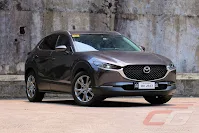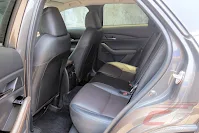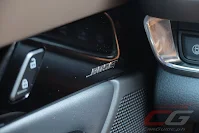It’s time to say goodbye to our long-term Mazda CX-30 after it joined our garage in July of last year. It’s rather abrupt, we know, but because we haven’t been doing a lot of driving lately, we figured this compact crossover could serve someone else better.
Still, in the twelve months or so since we had it, it’s served us very well. Despite the CX-30 having to share the already limited seat time with our CX-5, another member of our long-term test stable, we found that we’d equally proportion driving duties between our two Mazda crossovers (along with the countless other weekly test drives that we get).
The CX-30’s arrival during Mazda’s centenary year served as a perfect reminder that this plucky car manufacturer would always do things differently. In this case, they’ve managed an enviable blend of mainstream price tags and prestige design—something that all other Japanese manufacturers can’t seem to do.
Admittedly, if you’re looking at the Lexus UX, it might be good to cross shop that with this. You’ll be genuinely surprised how it can deliver the same or even a better experience at around half the price.
And that’s before you start delving into the details. Once you do, you’ll find all sorts of neat touches such as the way the LED turn signal lights are meant to pulse like a heart-beat, or how the center arm rest console slides back and up as not to hyperextend the elbow when opening or closing, or how the lighting stalk defaults to “Auto” to prevent you from driving at night using just the daytime running lights.
For P 1.990-million, the CX-30 AWD Sport (this Machine Gray color costs P 16,800 extra) is well-featured. Not only do you get the 8.8-inch widescreen infotainment, but you also get leather seats with a powered driver seat (with memory), a moonroof, and a dual zone climate control with rear vents. As standard, there’s also adaptive cruise control, lane keeping assist, a 360-degree camera, blind spot monitoring, and even autonomous emergency braking for both front and back.
Everyday usability is one of the CX-30’s strong suits. Not only is it easy to get a comfortable driving position, but details such as the operation of the infotainment system can’t be matched by any other offering in the segment.
On the road, the CX-30 feels compact, wieldy, and agile with sharp steering and body roll that’s always kept in check. It doesn’t feel as pliant through rough patches of road as well as other crossovers, but it’s by far the one that gives the most smiles per mile. The non-independent rear suspension sometimes betrays it as it jounces through cracks when going mid-corner, but for the most part, it’s mechanically solid.
The 2.0-liter Skyactiv-G engine gives run-of-the-mill power figures, but the CX-30 feels more than that. The tuning is done so well in that it offers good driving confidence whether in the city or on the highway. Even better, the fuel economy has stayed close to 9.5 km/L—and remember, this is an all-wheel drive crossover.
For all of the praises directed towards the CX-30’s design, its biggest miss has to be its interior packaging. Without a doubt, it’s great for single or newly-weds, but the limited rear seat space means it can’t fulfill the role of a family car as well as say, a similarly-priced compact SUV. The rear seats prioritize support over room, and this could be a problem for those trying to fit child seats—now made mandatory by the DOTr.
There are also a few niggles too like how the instrument cluster is a magnet for scratches, or how it developed numerous rattles which could only be solved by stuffing the affected areas with foam or old socks. The rear brakes also kept on emitting a squeal despite the pads being in good condition (as per our one and only dealer visit). These may be minor quips, but given that the rest of the CX-30 experience is considerably premium, they’re noticeable.
One thing often unmentioned is that Mazda only requires two dealer visits per year—every six months or every 10,000 kilometers whichever comes first. Plus, it’s all free—you don’t have to pay a single cent in periodic maintenance cost for the first five years. Not bad.
In the end, the Mazda CX-30 offers the right size with the right look along with the right level of comfort and equipment. If you’re looking for pure practicality, you might be disappointed; but if you’re looking for something that’s stylish, entertaining, and nicely-made, this one ticks all of the boxes. For as long as you’re the person sitting behind the wheel, you will never feel short-changed. We’ll miss it a lot, and we hope you’ll serve your new owner well.
2020 Mazda CX-30 AWD Sport Long-Term Test Wrap-Up
Months Since Last Report: 5
Kilometers Covered: 5,204
Kilometers Since Last Report: 1,135
Average Lifetime Fuel Consumption (km/L): 9.56
Best Fuel Consumption (km/L): 10.75 km/L
Worst Fuel Consumption (km/L): 8.40 km/L
Maintenance / Issues / Cost:
- Various interior rattles (fixed)
- Squealing from rear brakes (checked, not fixed)


















Any fix on the braking squeal at low speeds? I have been experiencing it as well in my 2020 Mazda 3. Brake pads are in good condition as well, braking performance is still excellent. However, the noise is quite annoying.
ReplyDeleteSadly, none so far. Brake cleaning seems to solve the problem temporarily, but it comes back after just a few hundred kilometers.
DeleteSorry...that's me...I don't know why my name came up as "Unknown." - Uly
DeleteGet the Levorg 2.0 turbo. It's way better than this overrated "premium" Mazda 3 on stilts
ReplyDelete